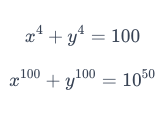I solved the question above from the quant practice set using a pattern approach. I am not sure if my logic violates exponent rules. I arrived at the same answer in the answer key but it’s very involved to follow through to get it right. Here is my approach below:
eq 1 — x^4 +y^4 = 10^2
eq 2 — (x^4)^50 + (y^4)^50 = (10^2)^50
since the pattern of eq 1 is “embedded” in eq 2, my logic is that
(x^4)^1/4 + (x^4)^1/4 = (10^2)^1/4 should be right and hence…
x + y = sqrt(10)
Therefore sqrt(10) < 4, and the solution has the same conclusion.
Is there any faulty thinking my my approach here?
Nice approach, but you need to be very careful since the “logic” you used is invalid.
In other words: you better know what you’re doing. If you do, it’s OK.
I see, thanks! I was approaching it from the input-output point of view as a function, but I see how that can be a tricky approach and not be a generalization.
@Leaderboard
Wanted to float another approach to solving this here rather than create a new thread.
I only used the x^{4}+y^{4} = 100 equation. I just kept taking a difference of squares until I got x+y.
Full disclosure, the I did the second half of the page after I saw that the solution included x+y = -/sqrt{10}. The idea is you factor out the -1 from each term and let it cancel out.
Any shortcomings of this approach??
Looks like a nice and creative approach to me - you do need to know what you’re doing (eg ignoring x^2 + y^2 = -10), but that’s also the case with the reference solution.
I don’t see how any of this logically follows. You do end up with the right answer, but it feels more like coincidence than sound reasoning.
x^2 x^2 = (10 + y^2)(10 - y^2) \;\not\!\!\!\implies (x^2 = 10 + y^2) \lor (x^2 = 10 - y^2)
For instance, 6 \cdot 6 = 4 \cdot 9 = 36, but 6 \neq 4 nor is it equal to 9.
This same error is “propagated” on the subsequent lines too.
The most natural way (if not already apparent) is to note that:
x^4 + y^4 = 10^2 \iff \big(x^4 + y^4\big)^{25} = \big(10^2\big)^{25} = 10^{50}
However, you’re also given that
x^{100} + y^{100} ={\big(x^{25})}^4 + {\big(y^{25})}^4 = 10^{50}
This suggests that, in this case, (a + b)^n = a^n + b^n, which can only happen if all the “middle terms” (in the binomial expansion) sum to zero. Since we know that a, b \geq 0, then it must be the case that either a or b equals 0. The rest follows trivially from here.
I think the point is that (both actually) the solution is exploiting symmetry (not as rigorous as it could be, as you pointed out - but it’s still a nice approach). Admittedly risky given that it’s QC, but I would classify this as “OK as long as you know what you’re doing”.
Your binomial solution is even more elegant though.

